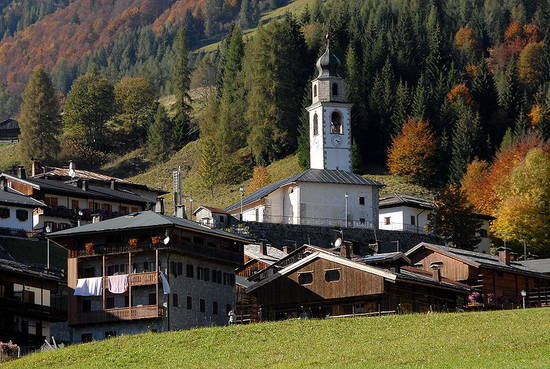
Visitors to the holiday resort of Forni di Sopra in the Carnic Dolomites, close to the source of the Tagliamento river, will be surprised to see that there is not much of a river in town. This is because a large proportion of the water is tapped at source and piped along an 18km tunnel bored in the rock to the northeast, to Sauris/Zahre (Friuli), to help fill an artificial lake which powers a hydroelectric plant completed after WW2. The dam—and more than that the all-weather motor road required for the building process (both engineering feats at the time)—marked the end of the isolation of Sauris, a settlement scattered on a plateau some 1200–1400m above sea level.
Before the road was built, access was severely restricted; indeed it was total isolation in the winter months up until the early 1950s, when as soon as it was practicable at the end of winter, an athletic carabiniere would be dispatched on foot all the way to Sauris from Forni di Sopra to check up on the community. Unlike the other Dolomites villages that used to make a living by dairy farming and kept their cows in the valleys in winter, moving them to the high pastures (malghe) in the summer, the people of the alpine plateau (then as now in the low hundreds) overwintered at high altitude and it must have been hard.
They lived in isolation for months but they are still here to tell the story. Indeed, as Sauris re-invents itself as a successful year-round holiday resort and purveyor of speciality foods, it is also going back to its roots, which sheds some light on the origins of such a challenging lifestyle.
The key is the language. Centuries of isolation have preserved the ‘Lingua Saurana’, which is now recognised by the Italian state as a separate language. You may not hear much of it spoken these days (apparently it is mainly used within the family) but it has its own museum (in Sauris di Sotto; open in the summer Mon, Thur, Fri 10–12 & 4–6; Sat and Sun 10–12 & 3–6), choir, publications, poetry and liturgical texts and it is taught in the local school, though after the first wave of enthusiasm it is now no longer compulsory, just an option. Eminent philologists have pored over it. A variant of German, it has over the centuries incorporated some of the local Friulano from the neighbouring valleys and a number of German elements from across the mountains; its roots, however, are further away, in southern Bavaria; it is a form of the Mittelhochdeutsch of the 13th century. Documents (unfortunately lost in a fire) testified to a community from 1280. According to local lore, the founding fathers were a couple of stray soldiers/deserters who abandoned the wars that were ravaging Europe and embraced extreme dairy farming. They had with them some relics of St Oswald, which fostered pilgrim traffic and accounts for the dedication of the present church. (Quite what Durham Cathedral, which boasts the complete body of this 7th-century Northumbrian saint, makes of the matter is not known.)
Today the Sauris plateau is for the discerning. There is no through traffic, which means the only visitors are people that chose to negotiate the winding road from Ampezzo; but one is richly rewarded. The endless meadows are wonderful, the air is the cleanest ever, the water is like nowhere else. Sauris has re-invented itself out of these unique attributes. Pork is cured here and prosciutto di Sauris is now a recognised delicacy. Beer in the characteristic white bottles requires no pasteurisation; it has a growing number of devotees. Whether the Saurians will be able to revive the local art of weaving (flax, hemp and wool), with the women preparing the thread and the men doing the weaving, remains to be seen. Presently good food is at the forefront and one would be well advised to pay a visit in the summer, especially at weekends in July and August, to sample it at the open-air market.
by Paola Pugsley, author of Blue Guide Aegean Turkey: From Troy to Bodrum.






